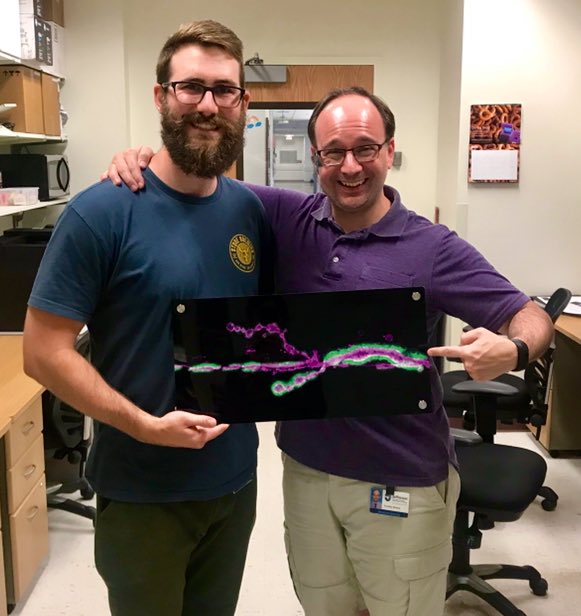OHHHHHHH WE GOT PREPRINT SIGN!!!!!!
just sit right back and you’ll hear a tale. a tale of a fateful … clip. and the tale of the latest scientific adventure from the @moscalab on bioRxiv!! https://www.biorxiv.org/content/10.1101/2020.11.18.387720v1
when the lab opened, @lucas__restrepo and i set out to solve a longstanding mystery that had wracked the developmental neurobiology and synaptic biology fields for a while (obvi, i’m scooby).
we know wnt signals at the synapse are UTTERLY CRITICAL for synaptic development. but some of the details are … fuzzy
landmark work from vivian budnik’s lab showed a crazy wnt signaling pathway where the c-terminus of the frizzled2 receptor (fz2-c) gets cleaved in postsynaptic muscles and imported into the nucleus to do … something.
but we’ve never been able to truly hammer down two things: what fz2-c does and what cleaves it. and that has bothered us something fierce because it is an important synaptic pathway! wnts do everything!
in this paper, we set out to do both of those things. and boy, did we find something! we first established that fz2 cleavage promotes synaptic maturation. if you block it, you get ghost boutons … hallmarks of failed maturation.
then @lucas__restrepo did a screen and found a protease that, when knocked down, caused the same kinds of maturation phenotypes. perhaps you’ve heard of this protease. it’s a little thing called GAMMA-SECRETASE!
mutations in presenilin, the catalytic subunit of gamma-secretase, are a major genetic link to alzheimer’s disease! but we don’t know nearly as much about what gamma-secretase does NORMALLY at the synapse!
we found that gamma-secretase localizes to developing postsynaptic regions and that removing any of the four subunits causes the same kinds of maturation defects as blocking fz2 signaling!
restoring gamma-secretase to the postsynapse (and NOT the presynapse!) rescues these maturation defects. so we know where it functions to mediate these important synaptic maturation processes.
we also found a behavioral deficit with impaired maturation! larvae couldn’t crawl quite as quickly and had an abnormal head movement behavior. this was only seen when gamma-secretase was impaired postsynaptically.
but these troubles were specific! @lucas__restrepo and @GAL4science showed that gamma-secretase mutants otherwise look disturbingly normal, so the maturation defects were not secondary to something else.
but gamma-secretase could be cleaving anything, you say! this could just be a wild coincidence!
so @lucas__restrepo did some genetics. and by some, I mean a HEROIC amount of genetics. and found that fz2 genetically interacted with gamma-secretase. so he could place them in the same pathway
using new constructs built by mike parisi, we found that fz2 and gamma-secretase co-localize at synapses, are close enough to interact, and that losing gamma-secretase blocks fz2-c nuclear entry and cleavage!
so WHOA! that’s the mystery right! finally! 20 years later, we figure out what protease is required for fz2 cleavage. that means gamma-secretase is a gatekeeper for synaptic maturation. maybe we’re biased here, but THAT’S SO COOL!
but hang on. still could just be a wild coincidence, right? so we tried a long shot. IF the relevant cleavage target IS fz2-c, what if we (hehehehe) cut out the middleman. what if we put pre-cut fz2 into the nucleus in gamma-secretase mutants? that should rescue it, right?
so @lucas__restrepo did that experiment and boy howdy. he could rescue the morphological AND behavioral deficits of every gamma secretase mutant! so fz2 cleavage is the relevant event lost in gamma-secretase mutants!
we identified (at last!) the mechanism promoting fz2 cleavage and it turns out to be a major neurodegeneration gene! we think gamma-secretase may be a gatekeeper of synaptic maturation. that gave us insight into what this important does NORMALLY so we can inform future study!
on top of that @SteveTym helped us show that gamma-secretase activity is needed for dendritic spine maturation AND libby moese showed that gamma-secretase is also needed in the fly CNS for synapse development. so it may be a broadly conserved mechanism!
but should we stop there? nah.
we wondered … is the link to alzheimer’s a fluke? or should we be thinking about synaptic maturation with other neurodegenerative diseases. because the easiest synapse to degrade might be one that wasn’t built correctly in the first place.
so we wanted to look for maturation failures in models of human neurodegenerative disease. we built the first fly CRISPR knock-in of a presenilin patient mutation and … GHOSTS! maturation defects!
then, we went a little nuts. we looked at every disease model we could get our hands on. to our great surprise, we found maturation defects in models of als, parkinson’s, and huntington’s diseases. it was a defect that united all of these models.
this is a previously unappreciated aspect of neurodegenerative diseases. and it offers a new and complicated angle to think about the biology that underlies these devastating disorders. we should be thinking about the neurodevelopmental component to neurodegeneration!
this story is an amazing team effort. led by a wildly talented technician @lucas__restrepo … he was the first member of the lab back when we had a tiny closet and no equipment! he’s in grad school now and his going away present was the first genetic interaction he found!!
and amazing assists from @GAL4science, @DuhartJC, @sonofasmurf, @SteveTym, + mike parisi, libby moese, hong fei (all not on the twitter bandwagon yet) who really made this work sing. i swear, i am the luckiest bastard ever to get the privilege of working with these scholars.
we'd love your feedback! let us know what you think, what we're missing, how to improve, how we should collaborate with you, or if anyone just wants to chat further! we've got TONS of ideas and MEGATONS of future directions!!

 Read on Twitter
Read on Twitter


